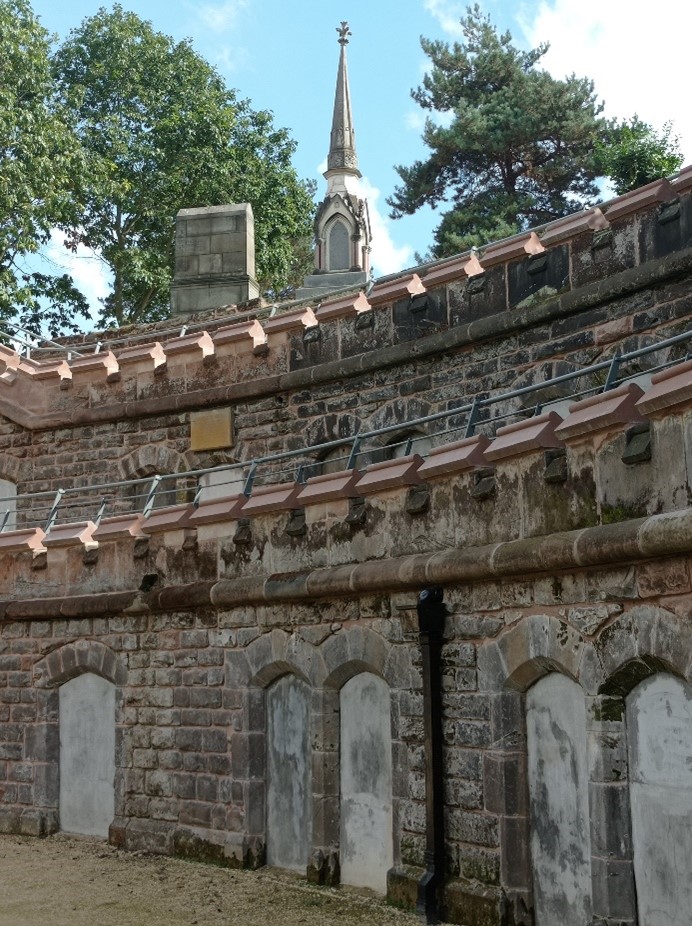As part of the Birmingham Heritage Week’s programme, I booked a visit for two places that, as a brummie, were unknown to me. These two locations are the cemeteries of Warstone Lane and Key Hill, both can be found at the heart of one of the most historical neighbourhoods of Birmingham, the Jewellery Quarter. Before my tour started, I went on a little walk through the first of the cemeteries, Warstone, to have a look around the place.
I spotted some beautiful graves’ designs during my brief expedition, also I had the chance to read some of the explanatory panels that are spread across the graveyard. At 11 o clock of a sunny Saturday, I began the official tour. A man named Richard was the guide for that day. Firstly, he shared with us some information about the role of the Jewellery Quarter Project and the associate known as Friends of Key Hill and Warstone Cemeteries.
After that, we heard a small introduction to Warstone’s history. The cemetery was created, as well as Key Hill, to help Birmingham cope with the amount of deaths that the city was sustaining. In the 1800s, the city had 6 parishes which could not take any more burials. In words of Richard, “the dead were burying the church of St Philips instead of the church burying its dead” due to the pressure that the burial land was suffering.
What we know as Warstone today, was once upon a time purchased for over £9000. The land has an extension of 9 acres and has more than 100000 buried on it. Also, there used to be a chapel within the cemetery, and underneath it was a big network of catacombs. In terms of types of graves, Warstone has both family ones (which go deep in the soil up to 22 feet) and public ones (some of them filled with hundreds of people).

Warstone Lane’s vaults. Image: @davidtravelwriter
One of the entrances of the cemetery has quite a story behind it. The entrance’s building has a remarkable gothic style and used to be the place were the company that managed the cemetery used to hold their boardroom meetings. Next to it, a war memorial is erected. Also, a small plaque remembers the heroic actions of private James Cooper.
Across the graveyard, I was shown some of the most iconic graves. One of them belongs to a famous druid called George William Marley, not far from there, there is the grave of the cemetery’s first burial (James Heath, aged 7) which was donated to the family by the company running the graveyard at the time. Other famous people who are at Warstone include John Baskerville, Harry James, Joseph Smith, or Jenkin William Evans.
There are some spooky stories about the place that make it a good adventure thought. When tunnelling the basements of a building near one of the cemetery’s walls, the construction made some coffins (literally) fell down. Constructors refused to keep digging. Also, in one of the public graves, there is a plaque in remembrance of 3 little children from the same family who died in strange circumstances within the same week.
One of the most intriguing parts of Warstone Lane is the catacombs’ area. Each of these vaults holds around 10 bodies, some of them conserved in metal coffins. Two catacombs used to belong to the University of Birmingham and the bodies inside of them were used in anatomy classes. Also, in one of the sections, there are another two vaults with holes on their doors so the coffins inside can be seen. Finally, there is a tunnel which is a restricted area nowadays, that used to connect the catacombs with the chapel’s basement.
After exploring the corners of Warstone Lane, it was time to do the same at Key Hill cemetery. The second tour was carried out by Richard as well, and despite that both graveyards are really close in distance, Key Hill seemed to me to be bigger and with more tombs. Firstly, we visited the entrance of the catacombs. As part of Birmingham Heritage Week, there were tours that went inside this area, which was not opened since last century.
.jpg)
Entrance to the catacombs of Key Hill. Image: @davidtravelwriter
While walking across Key Hill, Richard showed us some of the graves that have been restored thanks to the conservation project carried out by the Friends of Key Hill and Warstone Lane. As in the first graveyard, we got to see the graves of famous personalities such as Frank Tolkien (grandfather of the Lord of the Rings’ author, J.R.R Tolkien), Joseph Chamberlain (probably Birmingham’s most recognised politician ever), Marie Bethel (the first credited female reporter), or Joseph Gillott (a well-known philanthropist).
We ended up the tour visiting the Muslim and Jewish representation of graves and the Memorial Shield commemorating those killed in combat during. Overall, it was great to visit these cemeteries and learn a different part of Birmingham’s history through the lives and deaths of some of their most recognised people. Also, both Warstone Lane and Key Hill have some beautiful sculptures and ornamentation details, as well as an aura of peace and silence that makes you reflect about concepts like life and death.
Related
Comments
Comments are disabled for this post.









